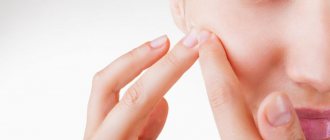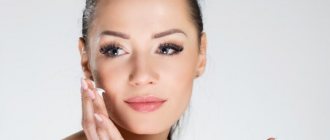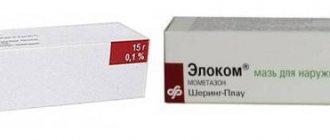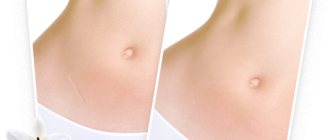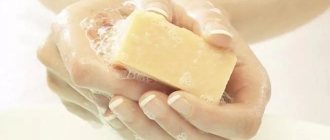- D Panthenol helps against acne
- Forms of Panthenol against acne
- Panthenol acne cream
- Panthenol acne spray
- Panthenol ointment for acne
- How to apply Panthenol products to your face for acne
- Panthenol for acne reviews
Panthenol is one of the most versatile soldiers in the fight against almost any skin disease. The drug is presented in various forms: in the form of cream, ointment, spray, aimed at treating skin problems associated with burns, calluses, hematitis, acne, wrinkles and many other diseases .
There are still active debates among many experts about the effectiveness and results of using D Panthenol for acne. The main question on the agenda in this article is to answer: Does Panthenol help with acne or is it intended only for the treatment of completely different diseases? But this remedy is also good It has also proven itself as an assistant in the fight against acne.
Pharmacy names of dexpanthenol
The name of the drug depends on the manufacturer producing it. In the pharmacy you can find the following names of the drug:
- D-Panthenol (Nizhpharm);
- Panthenol-ratiopharm (Ratiopharm);
- Dexpanthenol (Vertex);
- Panthenol (Micropharm);
- Panthenol ZD (Green oak grove);
- Panthenol Forte (Libriderm);
- Pantoderm (AKRIKHIN);
- Bepantent (Bayer Consumer Care AG).
The composition and release form depend on the pharmaceutical company that produces the drug.
To treat acne, various forms of dexpanthenol can be used in addition to ointment, which, due to its dense consistency, clogs pores and can contribute to the deterioration of the condition of the skin.
D-Panthenol
The Russian manufacturer Nizhpharm produces a medicinal product in the form of ointments and creams intended for external use. The ointment has a dense structure due to the content of petroleum jelly. It has a characteristic color (light yellow) and the smell of lanolin.
The cream has a lighter consistency, so it is preferable to use D-panthenol for facial acne in this form of release. It is characterized by white color, specific odor, homogeneity (homogeneity) and rapid absorption (absorbability).
The pharmaceutical company also produces D-Panthenol-Nizhpharm-Plus cream, which, in addition to the main active ingredient, contains chlorhexidine. The latter is known for its antiseptic properties, and is often used as an additional remedy in the treatment of acne. A similar drug is produced by the company Evalar.
Composition and release form
Dexpanthenol is a non-hormonal drug for the treatment of epidermal damage. Its main active ingredient is Dexpanthenol, or D-panthenol, a precursor of panthenoic acid, vitamin B5.
The product is available in both ointment and cream formats.
Let's take a closer look at the composition of Dexpanthenol:
- Dexpanthenol is a healing and regenerating component;
- Cetyl alcohol is an emollient. Neutralizes dry skin;
- Other components create the basis of the product and improve its structure and increase the absorption of the active substance.
Both cream and ointment have a uniform structure, are white in color, but differ in consistency: ointment is denser.
Consistency of the product
Dexpanthenol should be stored at room temperature according to the manufacturer’s advice - up to 25 °C. You should not store the product in the refrigerator or near heating devices, since if proper storage conditions are not observed, the product may deteriorate and lose its effectiveness.
Panthenol-ratiopharm
The product is produced by the German pharmaceutical company Ratiopharm in the form of an ointment containing 5% dexpanthenol. It is positioned by the manufacturer as a stimulator of tissue regeneration, which is recommended for use after opening boils to more quickly restore the skin and reduce the risk of scar formation after them.
It is not recommended to apply the drug to immature red inflamed skin elements due to the viscous consistency.
Contraindications
Dexpanthenol has only one contraindication - hypersensitivity to dexpanthenol itself.
Also, if the drug is used incorrectly or excessively, the risk of an allergic reaction may increase, the causes of which are often:
- High skin sensitivity to the active substance;
- Applying the drug in a thick layer;
- Presence of contraindications for use,
- Thoughtless use of the drug on infectious areas and manifestations of other skin diseases.
- Immediate reactions may be accompanied by:
- Skin rashes;
- Burning;
- Itching;
- Local swelling;
- Redness;
- Urticaria;
- Dermatitis.
Instructions
Dexpanthenol
The dermatoprotector from the Vertex company has several release forms intended for local use:
- ointment;
- gel;
- spray;
- solution.
In addition to the main active substance, the ointment is enriched with almond oil and beeswax. This form of release is not suitable for use with oily skin types. Its use is appropriate in the case of allergic acne and dermis prone to increased dryness.
Dexpanthenol for acne is best used in the form of a gel, which additionally contains glycerin, dimexide and alcohol. Glycerin has a moisturizing effect. Dimexide has analgesic, bactericidal and fibrinolytic (absorbable) properties. Alcohol is known for its antiseptic and drying effect. Due to its features, the dermatoprotector is very effective for painful and multiple rashes, after which spots may remain. Thus, the cream helps reduce pain, stop inflammation, suppress the growth of bacteria and get rid of acne marks characteristic of post-acne periods.
The spray is enriched with sea salt, which has an antiseptic effect. Can be used for acne.
The solution includes 0.5% sodium chloride. Suitable for wiping the skin for minor rashes.
Description of drug forms
According to medical statistics, the most famous and widespread type of Panthenol among the population is its form in the form of a spray (“foam”), which is easy to use and highly effective. However, there are also other dosage forms of this drug - cream and ointment, which differ in the composition of excipients and physical properties.
At first glance, it seems, what difference does it make which form of Panthenol is used, since each of them contains the same active ingredient? But it is important to understand that auxiliary products are responsible for the best penetration of Panthenol deep into the skin. And for different skin types, the interaction of various substances with it differs, so when choosing the most effective acne drug, you should rely on the individual nature of the skin.
Panthenol spray
Panthenol spray, as already mentioned, is the most popular form of this medicine. It's all about ease of use, as well as a watery base, which ensures rapid absorption of the active substance and easy cooling of the skin. Thanks to this, this drug effectively and quickly eliminates various skin irritations and promotes rapid healing.
It is reasonable to use an anti-acne spray in cases where the skin is problematic or oily - in such a situation, the base of the drug should be as gentle as possible. Foam or spray are the most suitable options for this reason.
In this case, the balloon is kept at a distance of 10-20 centimeters from the surface of the skin and they try to distribute the medicine as evenly as possible. If everything is done correctly, you won’t even have to remove the remaining foam - the spray will be absorbed into the fabric almost without any residue. Such procedures should be done 2-3 times a day.
Panthenol cream
Another rather gentle form of this drug is a cream, which is D-panthenol placed in a homogeneous hydrophilic environment like an emulsion. Thanks to this, it penetrates more actively into the thickness of the skin, leaves virtually no traces on the surface of the skin, but is still less easily tolerated by the skin than a spray. The cream also has the advantage that it is capable of creating large concentrations of the active substance in tissues, which increases its activity, but also increases the risk of side effects.
When fighting acne, Panthenol cream is used for dry or normal skin types. It is especially wise to use it in cases where the skin is prone to irritation - the cream base is very gentle, so it will not harm in this situation.
For oily skin, the cream is not recommended, especially when used on the face - this increases the load and prevents the skin from breathing.
You can use it 1-2 times a day, and it also combines well with other remedies against acne and acne. In the latter case, it must be applied no earlier than 20-30 minutes after using the previous drug. This use of Panthenol will not only speed up the disappearance of acne, but will also reduce the likelihood of developing side effects from more aggressive anti-acne products.
Panthenol ointment
An ointment with a concentration of the active substance of 5% is the most “heavy” version of this medicine for the skin, as it contains a lot of fat. Therefore, its use on the face is not recommended by cosmetologists for any skin type.
Its texture can impede skin breathing and block the pores and ducts of the sebaceous glands, which not only will not help eliminate pimples and blackheads, but can also provoke their new formation.
On the other hand, it is the ointment that is the most effective way to deliver the active substance to the skin, as it forms a depot of this compound on their surface. From there, D-panthenol gradually penetrates the epidermis for a long time, providing a lasting and pronounced effect.
Acne can occur not only on the face, but also on the neck and back - in the latter case, the ointment will come in handy, since the skin in this area is thicker. Therefore, it is mainly used in the fight against inflammatory manifestations there.
Just like on the face, the ointment does not provide a quick effect, but it actively accelerates skin restoration and normalizes the functioning of the sebaceous glands, which prevents the formation of new acne.
Panthenol
Micropharm dermatoprotector is produced in the form of a spray, aerosol and ointment.
The spray includes allantoin and vitamin E (tocopherol). The first component enhances the therapeutic effect of dexpanthenol. It is also known for its anti-inflammatory, antiseptic and astringent effects. Allantoin stimulates cell renewal, tightens pores and promotes exfoliation of dead epidermis. The drug is often used to treat various dermatological diseases, including acne. Tocopherol acts as an antioxidant and local immunostimulant. The spray can be used as an effective remedy for acne spots.
Application in skin care
Panthenol has established itself as an effective product for skin care of any type. It can be used to solve many problems, thanks to the safe composition and beneficial properties of the active components.
Dexpanthenol is involved in energy metabolism, growth and division of skin cells and accelerates metabolic processes in its tissues.
Therefore, Panthenol is a remedy necessary for the normal functioning of the skin . That is why it is successfully used in the fight against acne.
It is prescribed for problems such as:
- non-healing wounds, acne scars, cracks;
- wrinkles and peeling;
- inflammatory lesions of dry skin;
- dermatitis and allergic dermatosis.
The effect of Panthenol on the skin of the face:
- establishing fat and carbohydrate metabolism in tissues;
- restoration of skin cells;
- normalization of the sebaceous glands;
- improvement of blood microcirculation;
- regeneration (renewal) of skin tissue.
Read our article about using ichthyol ointment to get rid of acne.
Panthenol Forte
The cream is produced under the brand of the Libriderm series of facial skin care products. It contains a high concentration of dexpanthenol (9%), which is intended for dermis prone to irritation and inflammation. In addition to this component, the product includes vitamin E, aloe leaf extract and almond oil. Vitamin E nourishes the skin and increases local immunity, preventing the appearance of new rashes. Aloe extract has an anti-inflammatory effect, and almond oil has a moisturizing and softening effect.
The cream quickly heals remaining wounds after deep acne and helps prevent scarring.
Efficiency
Does Panthenol help with acne? When using Panthenol against acne and acne, you should not expect quick relief from inflammation .
It does not guarantee instant results, since it does not contain potent antibacterial components.
Its action is aimed at restoring the functions of the skin at the cellular level, so it has a cumulative result .
With regular use, Panthenol will improve skin health, cleanse pores and normalize sebum production. And this is the path to healthy and clear skin.
If you need to quickly get rid of acne, then you should use the recipes for the masks listed above with Panthenol. They are able to put the skin in order after the first use .
Masks with Panthenol for acne
For acne, masks based on dexpanthenol with the addition of:
- camphor oils;
- tea tree oils;
- aloe juice and lemon.
To half a teaspoon of cream, it is enough to add two drops of tea tree oil and the same amount of camphor oil or alcohol. The composition is applied to the inflamed areas, leaving to act for 15 minutes. You can make this mask up to 2 times a week.
For another mask recipe, you will need half a teaspoon of cream, the same amount of aloe juice and a few drops of lemon juice. The mixture is applied in a similar way and left to act for 10-15 minutes. The composition helps well against dark and red spots left after acne. Apply every 3-4 days until the problem is completely eliminated.


